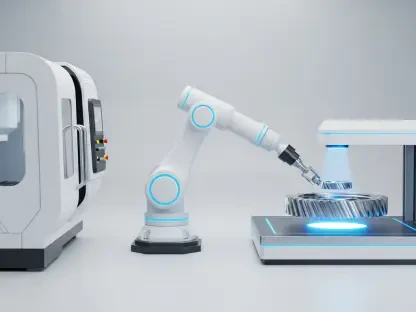As manufacturing environments evolve, the integration of Information Technology (IT) and Operational Technology (OT) offers unprecedented opportunities for innovation but also exposes critical vulnerabilities. Cyber threats, particularly ransomware, have become a significant concern, making robust IT/OT security frameworks indispensable for safeguarding operations and data integrity.
Understanding Operational Technology and Its Importance
Operational Technology Defined
Operational Technology (OT) encompasses the hardware and software used to control and monitor physical processes in manufacturing. From machinery to energy grids, OT systems are the backbone of production environments. They ensure that physical devices and processes run smoothly and efficiently, making them indispensable to manufacturing operations.
These systems are pivotal in maintaining operational continuity and optimizing workflows, yet they remain particularly susceptible to cyberattacks due to their essential role. The importance of OT cannot be overstated; an attack or disruption within these systems can lead to catastrophic results, including halted production lines and compromised product quality. As factories and production facilities evolve with smart technologies, the need to secure OT systems grows exponentially. This highlights that understanding OT’s intricacies is vital for implementing an effective cybersecurity strategy.
The Intersection of IT and OT
The convergence of IT and OT introduces new layers of complexity. While IT handles data-centric operations such as email and financial transactions, OT deals with the physical side of production. This integration offers efficiency and innovation but also heightens security risks as more systems become interconnected, creating potential entry points for cyberattacks.
This blending means that weaknesses in IT can have direct repercussions on OT, and vice versa. IT systems, traditionally focused on protecting data and ensuring digital security, now must address the physical repercussions that come with OT vulnerabilities. The interconnected nature of these systems means that a breach in the IT domain can potentially allow attackers to manipulate OT environments, disrupting production and causing physical damage. Consequently, this merging demands a new paradigm in security protocols, requiring IT and OT teams to work in concert, leveraging each other’s strengths for a unified defense front.
Navigating the Growing Cyber Threat Landscape
The Rise of Cyber Threats in OT
The blending of IT and OT has illuminated pressing security concerns. Cyberattacks targeting OT systems, especially ransomware, have surged, doubling in frequency annually. These attacks are not just about financial loss; they disrupt operations, damage equipment, and compromise safety protocols.
Ransomware attacks are particularly devastating, locking users out of critical systems and demanding payment for regained access. Unlike traditional IT environments, where data encryption might be the extent of the damage, OT environments face far more severe consequences. A compromised OT system can halt an entire factory, leading to substantial economic losses and, in some cases, threatening worker safety. The motivation for cybercriminals is clear: the higher the stakes, the higher the ransom they can demand. This escalating threat landscape necessitates an urgent reassessment of current security measures to ensure they are capable of defending against such sophisticated and impactful attacks.
The Dual Challenge: Cyber Threats and Operational Integrity
Cyber threats to OT environments carry significant risks. Vulnerabilities in legacy systems, operational disruptions, and data integrity issues all highlight the need for robust security measures. Cybercriminals exploit these weaknesses, causing production halts and potentially manipulating data to trigger faulty decision-making, jeopardizing operational integrity.
Legacy systems, often the backbone of many OT environments, are particularly at risk because they were not designed with modern cybersecurity threats in mind. These older systems lack the necessary safeguards to repel contemporary attack vectors, making them attractive points of entry for cybercriminals. Once inside, attackers can cause disruptions that ripple throughout the organization—halting production lines, damaging equipment, and altering data to skew production metrics. Ensuring operational integrity in the face of these threats requires a comprehensive approach that includes upgrading legacy systems, implementing real-time monitoring, and fostering a culture of security awareness among all employees.
The Dangers of Ransomware in Manufacturing
Operational Downtime
Ransomware’s impact on manufacturing can be catastrophic. Infected systems can bring production to a standstill, leading to severe financial losses. The downtime isn’t just costly—it delays product launches, disrupts supply chains, and affects overall business continuity.
In a tightly integrated supply chain, even minor disruptions can have magnified consequences. A single ransomware attack can create a ripple effect, halting the work of secondary suppliers and delaying deliveries to end customers. This cascading effect underscores the need for resilient cyber defenses capable of minimizing downtime and maintaining operational continuity. Additionally, companies must develop and regularly update contingency plans to ensure that they can quickly restore systems and resume operations should an attack occur.
Damage to Brand Reputation
Beyond immediate financial implications, ransomware attacks can significantly damage a company’s brand. Publicized breaches erode customer trust and harm long-term relationships. A tarnished reputation can have far-reaching consequences, influencing market position and customer loyalty.
The aftermath of a cyberattack often extends beyond the IT and OT departments, affecting the entire organization. Public perception, especially in today’s interconnected digital world, can be severely impacted by a security breach. Customers and clients, upon learning of a breach, may question the company’s reliability and commitment to safeguarding their interests. This loss of confidence can lead to decreased sales, lost contracts, and long-term damage that can take years to repair. To mitigate these risks, companies must be transparent about their security practices and proactive in demonstrating their commitment to protecting sensitive information.
Building Resilient IT/OT Security Frameworks
Comprehensive Risk Assessment
Regular risk assessments are fundamental to identifying vulnerabilities and understanding the evolving threat landscape. A thorough evaluation helps pinpoint potential attack vectors and enables proactive measures to mitigate risks before they materialize into breaches.
Risk assessments should be a recurring activity and not a one-time event. As the cybersecurity landscape changes, so do the risks and potential points of vulnerability. By continuously evaluating their systems, companies can stay ahead of emerging threats and adapt their security measures accordingly. These assessments should also involve input from various departments, ensuring a holistic view of the organization’s security posture and fostering interdepartmental collaboration in developing and implementing effective security strategies.
Segmentation and Isolation
Implementing network segmentation is critical. By isolating critical OT systems from other networks, companies can limit malware spread and prevent systemic compromise. Segmentation creates firewalls within the network, ensuring that breaches in one area don’t cascade into others.
Network segmentation is a proven strategy for containing cyber threats. By dividing the network into isolated segments, businesses can limit the movement of malicious actors, reducing the potential impact of a breach. For instance, even if a cybercriminal gains access to the IT network, segmentation would prevent them from easily breaching the OT network. This containment strategy is essential for protecting critical infrastructure and ensuring business continuity. Alongside segmentation, employing robust access control mechanisms ensures that only authorized personnel can interact with sensitive OT systems, further strengthening the overall security framework.
Advanced Threat Detection
Leveraging AI and Machine Learning (ML) for real-time monitoring enhances threat detection capabilities. These technologies can identify unusual patterns and anomalies faster than traditional methods, enabling quicker and more precise responses to potential threats.
AI and ML bring a dynamic edge to threat detection. Unlike traditional rule-based systems, they can learn and adapt to new threats autonomously. This ability to detect previously unknown threats in real-time significantly bolsters an organization’s defense capabilities. Implementing AI and ML technologies requires not only the right tools but also skilled personnel who can interpret the data and respond effectively. Investment in these areas is crucial for staying ahead of sophisticated cyber threats, allowing organizations to swiftly respond to incidents and mitigate potential damage.
Patch Management
Timely updates and patch management are essential, especially for legacy systems often found in OT environments. Regularly applying patches closes security gaps and reduces vulnerabilities that cybercriminals could exploit.
Patch management is a critical component of any cybersecurity strategy. Unpatched systems are akin to open doors, inviting cybercriminals to exploit known vulnerabilities. Organizations must establish a rigorous schedule for applying patches, particularly for legacy OT systems that are more susceptible to attacks. Beyond simply applying updates, companies should also maintain an inventory of all hardware and software assets to ensure that no system falls through the cracks. This proactive approach to patch management is vital for closing security gaps and maintaining a robust defense posture.
Employee Training and Awareness
Human error remains a leading cause of security breaches. Regular training ensures employees are vigilant and knowledgeable about recognizing and responding to potential threats. Building a culture of security awareness can significantly mitigate risks.
The human element is often the weakest link in cybersecurity. Employees can unintentionally create vulnerabilities by falling prey to phishing attempts or failing to follow security protocols. To combat this, comprehensive and ongoing training programs are essential. These programs should educate employees about the common tactics used by cybercriminals and provide clear guidelines on how to respond to potential threats. Encouraging a culture of vigilance and accountability ensures that every employee understands their role in maintaining the company’s cybersecurity posture.
Incident Response Planning
A well-developed incident response plan is vital. It should outline clear steps for managing various cyber incidents, ensuring rapid and effective containment and recovery. Regular updates to this plan help adapt to new threats and maintain preparedness.
Incident response plans are the cornerstone of effective crisis management. When a cyber incident occurs, a structured response is crucial to mitigate damage and restore normal operations. These plans should detail the roles and responsibilities of all team members, communication protocols, and step-by-step procedures for containing and resolving the incident. Regular drills and simulations can help ensure that the team is well-prepared and can act swiftly in the face of a real threat. Keeping the response plan up-to-date with the latest threat intelligence ensures that the organization remains resilient against evolving cyber threats.
The Opportunities in Secure IT/OT Integration
Accelerated Time-to-Market
Secure IT/OT integration can enhance time-to-market by identifying and eliminating production bottlenecks. Advanced analytics provide insights that streamline production processes, enabling faster development and launch of new products.
Integrating IT and OT securely not only protects operations but also enhances efficiency. Advanced data analytics tools can pinpoint inefficiencies and bottlenecks within the production line, offering actionable insights that can expedite processes. This acceleration allows companies to bring new products to market more quickly, maintaining a competitive edge. Additionally, secure integration ensures that data integrity is preserved, leading to more accurate forecasting and planning. Companies that invest in secure IT/OT integration position themselves to leverage technological advancements effectively while safeguarding their operational continuity.
Enhanced Operational Efficiency
AI and ML can optimize workflows, predict maintenance needs, and reduce downtime. Secure environments ensure data integrity, allowing these technologies to function effectively and drive continuous improvement in operations.
Operational efficiency is paramount for maintaining a competitive advantage in the manufacturing sector. AI and ML, when integrated into a secure environment, can transform operations. These technologies can predict when machinery will require maintenance, preventing unexpected breakdowns and reducing downtime. Automated workflows streamline processes, increasing productivity and reducing the margin for error. Secure integration ensures that the data driving these intelligent systems is accurate and reliable, further enhancing efficiency gains. By embracing these technologies, manufacturers can achieve higher levels of operational efficiency, reducing costs and increasing their overall competitiveness.
Agile Response to Market Changes
Data-driven operations enable quick pivots in response to emerging trends. Secure environments facilitate reliable data analytics, empowering companies to make informed decisions and adapt swiftly to market demands.
In today’s fast-paced market, agility is essential. Companies must be able to respond quickly to changes in consumer demand, new regulations, and emerging technologies. Secure IT/OT integration enables real-time data analytics, providing the insights needed to make informed decisions rapidly. This agility allows manufacturers to pivot their production lines, adjust their strategies, and capitalize on new opportunities as they arise. By maintaining a secure environment, companies can trust the data they rely on, ensuring that their decisions are based on accurate and up-to-date information. This capability is crucial for maintaining a competitive edge in a dynamic marketplace.
Collaborating for Robust IT/OT Security
Partnership with Technology Experts
Developing robust IT/OT security frameworks requires collaboration with technology partners, industry experts, and regulatory bodies. Working together ensures the implementation of best practices and the adoption of cutting-edge security technologies.
No single organization can address all cybersecurity challenges on its own. By partnering with technology experts, businesses can leverage specialized knowledge and innovative solutions that enhance their security posture. Industry experts can provide valuable insights into emerging threats and best practices, while regulatory bodies can offer guidance on compliance and standards. This collaborative approach ensures that companies stay ahead of cyber threats and adopt the most effective security measures. Technology partnerships can also facilitate access to advanced tools and resources that may be beyond the reach of individual organizations, further strengthening their defenses.
Fostering a Security-Centric Culture
As manufacturing landscapes continue to evolve, the convergence of Information Technology (IT) and Operational Technology (OT) creates remarkable opportunities for innovation. This integration facilitates automated processes, enhances production efficiency, and allows for the collection of vast amounts of data, which can be leveraged for improved decision-making and predictive maintenance. However, along with these advancements come significant risks. One of the most pressing concerns is the rise in cyber threats, particularly ransomware attacks targeting critical infrastructure. These threats can lead to devastating consequences, including operational disruptions, data breaches, and financial losses.
To counter these vulnerabilities, it is essential to implement robust IT/OT security frameworks. These frameworks should encompass a multi-layered approach to cybersecurity, incorporating elements such as network segmentation, continuous monitoring, threat intelligence, and incident response strategies. By adopting such comprehensive measures, manufacturers can better safeguard their operations and ensure data integrity.
In summary, while the integration of IT and OT offers unprecedented potential for growth and efficiency in manufacturing environments, it also necessitates a vigilant approach to cybersecurity. Ensuring the resilience of these integrated systems against cyber threats is crucial for maintaining operational continuity and protecting valuable data assets.









